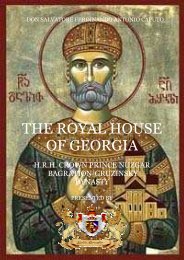here - Nobility Associations
here - Nobility Associations
here - Nobility Associations
You also want an ePaper? Increase the reach of your titles
YUMPU automatically turns print PDFs into web optimized ePapers that Google loves.
PREFACE<br />
The House of Hohenstaufen, also known as the Swabian dynasty or<br />
the Staufen, was a dynasty of German monarchs in the High Middle Ages,<br />
reigning from 1138 to 1254. Three members of the dynasty were crowned Holy<br />
Roman Emperors. In 1194, the Hohenstaufens were granted the Kingdom of Sicily.<br />
The terms Hohenstaufen and Staufen also identified the family's Hohenstaufen<br />
Castle in Swabia, located on an eponymous mountain near Göppingen. This second<br />
castle was built by the first known member of the dynasty, Duke Frederick I.<br />
The founder of the line was the count Frederick (died 1105), who built Staufen<br />
Castle in the Swabian Jura Mountains and was rewarded for his fidelity to Emperor<br />
Henry IV by being appointed duke of Swabia as Frederick I in 1079. He later<br />
married Henry’s daughter Agnes. His two sons, Frederick II, duke of Swabia, and<br />
Conrad, were the heirs of their uncle, Emperor Henry V, who died childless in 1125.<br />
After the interim reign of the Saxon Lothar III, Conrad became German king and<br />
Holy Roman emperor as Conrad III in 1138. Subsequent Hohenstaufen rulers were<br />
Frederick I Barbarossa (Holy Roman emperor 1155–90), Henry VI (Holy Roman<br />
emperor 1191–97), Philip of Swabia (king 1198– 1208), Frederick II (king, 1212–50,<br />
emperor 1220–50), and Conrad IV (king 1237–54). The Hohenstaufen, especially<br />
Frederick I and Frederick II, continued the struggle with the papacy that began<br />
under their Salian predecessors, and were active in Italian affairs.<br />
Following the death of Henry V (r. 1106-25), the last of the Salian kings, the dukes<br />
refused to elect his nephew because they feared that he might restore royal power.<br />
Instead, they elected a noble connected to the Saxon noble family Welf (often<br />
written as Guelf). This choice inflamed the Hohenstaufen family of Swabia, which<br />
also had a claim to the throne. Although a Hohenstaufen became king in 1138, the<br />
dynastic feud with the Welfs continued. The feud became international in nature<br />
when the Welfs sided with the papacy and its allies, most notably the cities of<br />
northern Italy, against the imperial ambitions of the Hohenstaufen Dynasty. Their<br />
rule in south Italy was to be brief, lasting from 1194 to 1266. In many ways it was a<br />
continuous of the Norman period, but with the Greek and Arabic elements<br />
progressively displaced by Western ones, as the political and economic links of the<br />
Regno shifted northwards.<br />
Frederick II (26 December 1194 – 13 December 1250), was one of the most<br />
powerful Holy Roman Emperors of the Middle Ages and head of the House of<br />
Hohenstaufen. His political and cultural ambitions, based in Sicily and stretching<br />
through Italy to Germany, and even to Jerusalem, were enormous; however, his<br />
enemies, especially the popes, prevailed, and his dynasty collapsed soon after his<br />
The Hohenstaufen Dynasty - Page 9 of 200



